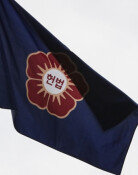The Jushin

Have you heard of an ethnic group called the Jushin? This unfamiliar ethnicity is apparently a common forefather to Northeast Asian countries, such as Korea, Japan and China, according to Professor Kim Un-hoi of Dongyang University in his recently published book, Finding Jushin (2 volumes).
He claims the Jushin are a common ancestor that connects the civilizations of Mongolia, Manchuria, the Korean Peninsula and Japan, and that they spread the use of metal in those areas.
Kim is famous for his extensive knowledge of Chinese history and is the author of the book, Reading the Romance of the Three Kingdoms Correctly (2004), which discussed Sino-centrism hidden in Romance of the Three Kingdoms. He is now advocating the great Jushin theory using his knowledge not only of history, but of anthropology, mythology, and archaeology as well.
Several Names, One Ethnicity-
Chinese history books have divided ancient barbarian ethnic groups living in Manchuria and the Korean Peninsula into three groupings: Dongho, Sukshin, and Yemaek. Korean historians say that the Yemaek ethnic group joined ethnic Han people that lived in the southern part of the Korean Peninsula and became what is known today as the Han ethnic group.
Chinese historians say that these ethnicities were absorbed into Chinas civilization, and that they are part of Chinas history.
Professor Kim Han-kyu of Sogang University caused a stir in 2004, however, saying, Dongho, Sukshin, and Yemaek are neither Chinese nor part of the Han, and therefore not part of either Korean history or Chinese history. They are part of Yodong history.
Professor Kim Un-hois Jushin theory argues against Chinas by saying, Not only Dongho, Sukshin, and Yemaek, but also the Han people and Japanese, all come from the same ancestor which has an ethnic identity separate from the ethnic Han of China.
Kim points out the route of the gradual spread of ancient culture, which has characteristics such as earthenware with comb-like patterns, lute-like bronze swords, and dolmens. It existed around the valley of Lioaho, and then gradually moved to Yodong, the Korean Peninsula, and Japan. He also writes about research results that show the close genetic aspects of people from what are now Mongolia, Manchuria, Korea, and Japan, and anthropological research that shows the similarity in languages between these areas.
He points out that the creation myths of these areas all have similar features, including mixtures of myths about gods and men, and the appearance of a master archer in all of them. The myths also share words like iron, new, sun, brightness, morning, fire, and metal, that are all connected in meaning.
Professor Kim adds all these factors up and concludes that a nomadic race with highly sophisticated bronze working skills from the Altai Mountains around 7 B.C. moved south near Chinas Herbei and Sandung areas. Some then moved back to Manchuria, some traveled west to Mongolia, some went to the Korean Peninsula, and some headed south to Japan.
Chinese history books list several names for this same race because, according to Kim, as this race continued to move, confusion arose due to differences in time and place. It can be seen as similar to Koreans being called Joseon, Goryeo, and Koreans depending on their home regions.
Similarities Between the Kori, Jushin-
Then why is this ancient ethnicity called the Jushin? The name of the ethnicity can largely be divided into Kori and Jushin. Kori is the ethnic name of the ethnicity when it first formed itself in Altai, and has changed to Guryeo, Gori, Goguryeo, and Goryeo since then. The word is probably derived from the word copper, which is Guri in Korean. It could also mean heaven.
Jushin has been referred to over time as Joseon, Sukshin, Shikshin, Jikshin, and Jushin, which may differ in spelling in Chinese characters, but which all have similar pronunciations. The word Jushin is a combination of the words for sun, morning and mountain.
References to Kori are found in Han history, but Jushin have appeared in Manchuria and the Korean Peninsula, so Jushin is more comprehensive in this sense. The Manchurian ethnicity which founded the Ching Dynasty called themselves Jushin at first, but later changed their name to Manchu from the terms Munsu and Manjusri, the Bodhisattva of wisdom and intellect.
Professor Kim also writes that the history books of Ching and Gum founded by Manchurians say their forefathers include Kim Hahm-bo of the Shilla Kingdom. Gum and Ching changed their first names to Aishinjaorwo, which means gold (pronounced geum), and use Chinese characters to mean, To love and remember Shilla.
Professor Kim looks at famous Asian history books and discovers one by one the common identity of different ethnic groups including the Han, Chi-tan, and Manchurian, Mongolian and Japanese. His explanation that a nomadic race traditionally brings its hometowns name with it when it moves explains similar regional names such as Bakdal Mountain, Pyongyang, Arisu, and Asadal in Altai, Mongolia, Korea, and Japan, respectively.
He adds that if Chinas Han has its source from Han, then Jushins source is Goguryeo, and warns that if Goguryeo becomes part of Chinese history, then the history of the Jushin, who connect the past and future of Mongolia, Manchuria, Korea, and Japan, will fade away.
Chae-Hyun Kwon confetti@donga.com
Headline News
- Med professors announce intention to leave hospitals starting Thursday
- Bridge honoring Sgt. Moon Jae-sik unveiled in Pennsylvania
- Chief of Staff Chung tells presidential secretaries to stay away from politics
- US FTC bans noncompete agreements
- N. Korea launches cyberattacks on S. Korea's defense companies







